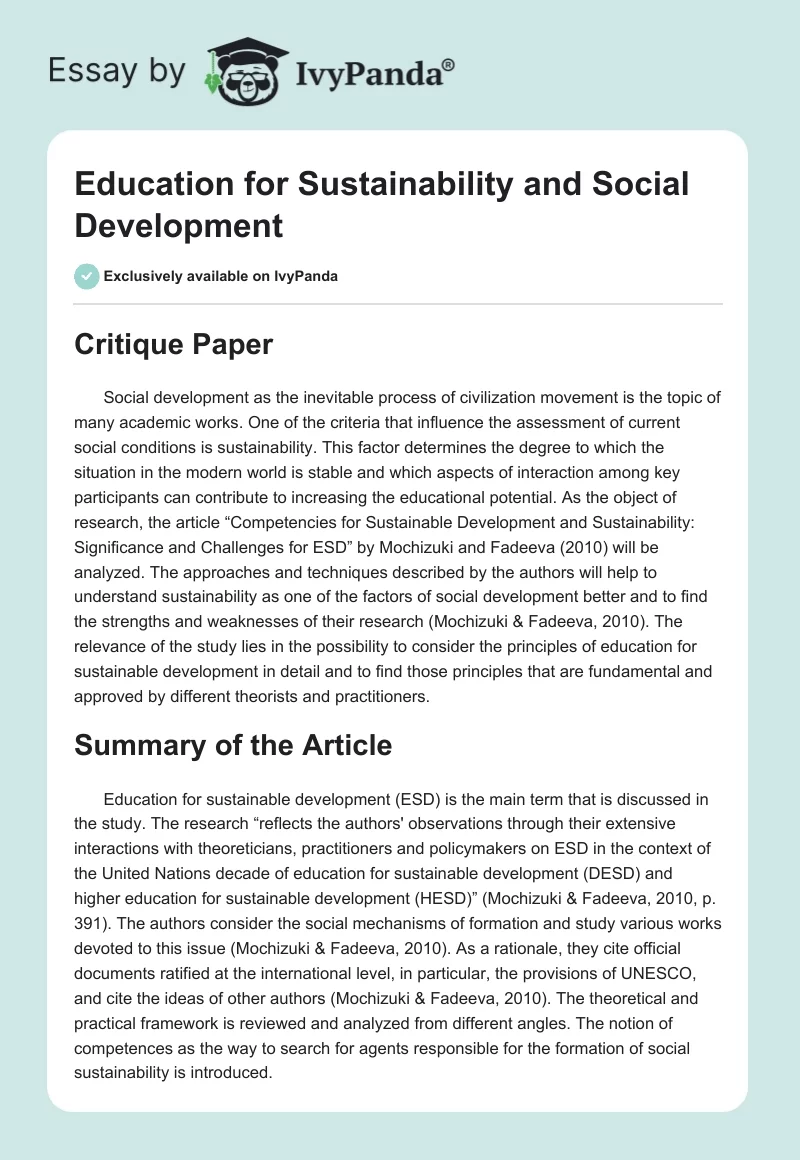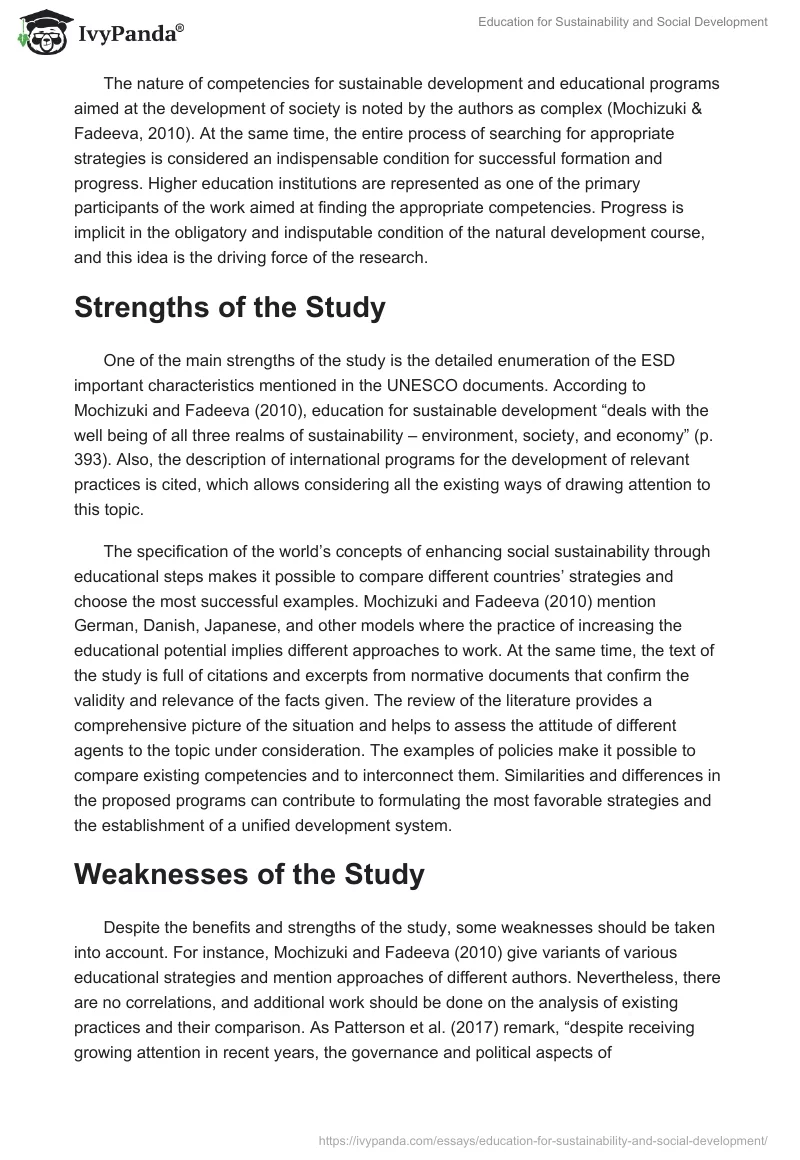Critique Paper
Social development as the inevitable process of civilization movement is the topic of many academic works. One of the criteria that influence the assessment of current social conditions is sustainability. This factor determines the degree to which the situation in the modern world is stable and which aspects of interaction among key participants can contribute to increasing the educational potential.
As the object of research, the article “Competencies for Sustainable Development and Sustainability: Significance and Challenges for ESD” by Mochizuki and Fadeeva (2010) will be analyzed. The approaches and techniques described by the authors will help to understand sustainability as one of the factors of social development better and to find the strengths and weaknesses of their research (Mochizuki & Fadeeva, 2010). The relevance of the study lies in the possibility to consider the principles of education for sustainable development in detail and to find those principles that are fundamental and approved by different theorists and practitioners.
Summary of the Article
Education for sustainable development (ESD) is the main term that is discussed in the study. The research “reflects the authors’ observations through their extensive interactions with theoreticians, practitioners and policymakers on ESD in the context of the United Nations decade of education for sustainable development (DESD) and higher education for sustainable development (HESD)” (Mochizuki & Fadeeva, 2010, p. 391). The authors consider the social mechanisms of formation and study various works devoted to this issue (Mochizuki & Fadeeva, 2010).
As a rationale, they cite official documents ratified at the international level, in particular, the provisions of UNESCO, and cite the ideas of other authors (Mochizuki & Fadeeva, 2010). The theoretical and practical framework is reviewed and analyzed from different angles. The notion of competences as the way to search for agents responsible for the formation of social sustainability is introduced.
The nature of competencies for sustainable development and educational programs aimed at the development of society is noted by the authors as complex (Mochizuki & Fadeeva, 2010). At the same time, the entire process of searching for appropriate strategies is considered an indispensable condition for successful formation and progress. Higher education institutions are represented as one of the primary participants of the work aimed at finding the appropriate competencies. Progress is implicit in the obligatory and indisputable condition of the natural development course, and this idea is the driving force of the research.
Strengths of the Study
One of the main strengths of the study is the detailed enumeration of the ESD important characteristics mentioned in the UNESCO documents. According to Mochizuki and Fadeeva (2010), education for sustainable development “deals with the well being of all three realms of sustainability – environment, society, and economy” (p. 393). Also, the description of international programs for the development of relevant practices is cited, which allows considering all the existing ways of drawing attention to this topic.
The specification of the world’s concepts of enhancing social sustainability through educational steps makes it possible to compare different countries’ strategies and choose the most successful examples. Mochizuki and Fadeeva (2010) mention German, Danish, Japanese, and other models where the practice of increasing the educational potential implies different approaches to work. At the same time, the text of the study is full of citations and excerpts from normative documents that confirm the validity and relevance of the facts given. The review of the literature provides a comprehensive picture of the situation and helps to assess the attitude of different agents to the topic under consideration. The examples of policies make it possible to compare existing competencies and to interconnect them. Similarities and differences in the proposed programs can contribute to formulating the most favorable strategies and the establishment of a unified development system.
Weaknesses of the Study
Despite the benefits and strengths of the study, some weaknesses should be taken into account. For instance, Mochizuki and Fadeeva (2010) give variants of various educational strategies and mention approaches of different authors. Nevertheless, there are no correlations, and additional work should be done on the analysis of existing practices and their comparison. As Patterson et al. (2017) remark, “despite receiving growing attention in recent years, the governance and political aspects of transformations remain arguably under-developed in the global sustainability literature” (p. 1). It means that interest in this topic should be supported by a detailed review of possible development options. If this study had a stronger emphasis on probability rather than on factors, the practical value would be more significant.
Also, some visual aids might be useful. In the study conducted by Patterson et al. (2017), there is a graph that demonstrates the development of certain strategies. In the study under consideration, there is much theoretical information, which, however, is perceived as difficult because of numerous scientific terms and the lack of graphic aids. Visualization could help to compile some of the findings and make conclusions more comprehensible.
Importance and Implications for the Society
Regardless of the number of strengths and weaknesses, the study by Mochizuki and Fadeeva (2010) is of practical value and is important for the society as a whole. Those sustainability parameters that are discussed are valuable material for considering the entire development process carefully and drawing the right conclusions. Educational institutions may take a course to support new trends and directions and to strengthen the existing base. Moreover, stakeholders can join forces to achieve a common goal and use existing experience in order to develop a unified and stable mechanism for the formation of an educationally sustainable society. Such an approach will make it possible to strengthen those aspects of state policies that do not have a sufficiently strong theoretical basis and will help to work successfully for the sake of achieving the set goals.
Corresponding approaches are numerous, which opens wide prospects for discussions and implementation. As Mochizuki and Fadeeva (2010) argue, “the paper contributes to a broader debate on strategies of implementation of ESD and education for sustainability (EfS) by mapping arguments on competences for SD and sustainability with a particular focus on higher education institutions” (p. 391). Therefore, society can follow the new and sustainable path of development if the right measures are taken to analyze and evaluate the practices described.
Conclusion
These principles of educational methods aimed at increasing sustainability through the work of higher education institutions are numerous and have a justified basis. The study has a number of strengths, however, some weaknesses also deserve particular attention. The importance of society lies in an opportunity to increase sustainability indicators and to reconsider existing approaches and policies in order to form a more educationally strong course of life.
References
Mochizuki, Y., & Fadeeva, Z. (2010). Competences for sustainable development and sustainability: Significance and challenges for ESD. International Journal of Sustainability in Higher Education, 11(4), 391-403. Web.
Patterson, J., Schulz, K., Vervoort, J., Van Der Hel, S., Widerberg, O., Adler, C.,… Barau, A. (2017). Exploring the governance and politics of transformations towards sustainability. Environmental Innovation and Societal Transitions, 24, 1-16. Web.


